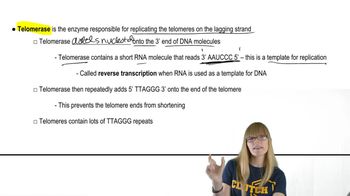Table of contents
- 1. Introduction to Genetics51m
- 2. Mendel's Laws of Inheritance3h 37m
- 3. Extensions to Mendelian Inheritance2h 41m
- 4. Genetic Mapping and Linkage2h 28m
- 5. Genetics of Bacteria and Viruses1h 21m
- 6. Chromosomal Variation1h 48m
- 7. DNA and Chromosome Structure56m
- 8. DNA Replication1h 10m
- 9. Mitosis and Meiosis1h 34m
- 10. Transcription1h 0m
- 11. Translation58m
- 12. Gene Regulation in Prokaryotes1h 19m
- 13. Gene Regulation in Eukaryotes44m
- 14. Genetic Control of Development44m
- 15. Genomes and Genomics1h 50m
- 16. Transposable Elements47m
- 17. Mutation, Repair, and Recombination1h 6m
- 18. Molecular Genetic Tools19m
- 19. Cancer Genetics29m
- 20. Quantitative Genetics1h 26m
- 21. Population Genetics50m
- 22. Evolutionary Genetics29m
8. DNA Replication
Telomeres and Telomerase
Problem 38b
Textbook Question
Textbook QuestionGo to the OMIM website (https://www.ncbi.nlm.nih.gov/omim) and type 'dyskeratosis congenita autosomal dominant 1' (DKCA1) into the search bar. The result will include a clickable link to the disorder that has an OMIM number of 127550. Review the OMIM information you retrieve and notice that this disorder is caused by a mutation of a telomerase gene that results in abnormally rapid shortening of telomeres and the appearance of disease symptoms at progressively younger ages in successive generations of the affected families. Use this and other information on OMIM to assist with this problem. Go the reference number 15 at the bottom of the OMIM page for a link to a 2004 paper by Tom Vulliamy and colleagues that appeared in the journal Nature Genetics. Click on the 'Full text' option and download a copy of the paper. Look at Table 1 of the paper on page 448. This table lists the lengths of telomeres measured in members of the families in this study. Telomeres shorten with age, and the telomere lengths in Table 1 are age-adjusted. The negative numbers for telomere lengths in the table indicate that telomeres are shorter than average for age, and the more negative the number, the shorter the telomere. Based on Table 1, discussion in the Vulliamy et al. (2004) paper, and information available on OMIM answer the following: Why are telomeres of people with DKCA1 shorter than average?
 Verified Solution
Verified SolutionThis video solution was recommended by our tutors as helpful for the problem above
Video duration:
4mPlay a video:
242
views
Was this helpful?
Video transcript
Related Videos
Related Practice
